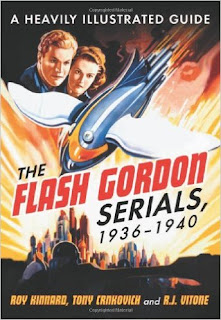 |
| Grant Gustin as The Flash |
THE FLASH (2014 WB television series).
This hit TV series is based on a comic book character that first appeared in 1956 (
Showcase 4), who in turn was based on a speedster of the same name (if different origin) that appeared in the 1940's (or "golden age" of comics). The silver age series ran for 350 issues over many years, after which that character's nephew, Wally West, took over. The Flash was police scientist Barry Allen, who was killed off about the time that the comic book series ended. Barry Allen came back from the dead, and got his own series again, although the character has been reinvented for modern times. The same is true for this television series, which mixes various comic mythologies to come up with its own take on the character. There was also a series about
The Flash, in 1990, in which Barry Allen was played by John Wesley Shipp, who is cast as Barry's father in the new series.
The Flash is a little more realistic (if that's the word!) than the old comic series, which was often comically, but charmingly, absurd, yet it borrows many characters and concepts from the comic while fashioning some of its own. Although the boyish Grant Gustin -- he looks about sixteen -- doesn't seem old enough to be a police scientist, he is a fine, sensitive actor and is perfect casting for
this Barry Allen/Flash. The comic book Flash works on his own or with members of the Justice League, but in this show he has a whole group of supporting characters -- too many, perhaps, as if it's a super-hero
committee -- assisting him, although most of these characters are as appealing as the actors who play them.
As in the comics, the main adversary is the Reverse-Flash or Professor Zoom. In the silver age these sinister speedsters were the same person, one Eobard Thawne from the future, but when Allen's nephew Wally West took over as Flash, there was also a new Zoom, Hunter Zolomon. Frankly, it's hard to tell these two characters apart. Making things even more confusing, the Zoom of the first season of the show was Thawne, but now he appears to be Zolomon, a Zoom from a different dimension, perhaps. Adding to the confusion is that the sympathetic character of Jay Garrick (Teddy Sears), who plays the Flash of "Earth-2" (essentially the golden age Flash, who had the same secret identity and also wears a helmet like Mercury) turns out to actually be Zoom! Hopefully this will all be explained in subsequent episodes.
The creators and writers of
The Flash obviously know their comic book history and are respectful of the character's colorful past, rich back story, and often bizarre villains. In the episode in which Barry discovers the dimension of "Earth-2" where another Flash, Jay Garrick resides, the show uses a variation of a scene which appeared on the cover of the classic issue 123 of the silver age Flash: a person calls out for help from the Flash as he's about to be killed and both Jay and Barry, in costume, rush toward the near-victim shouting "I'm coming!' The title of this episode is the same as the title of
Flash 123: "Flash of Two Worlds." Cute, eh?
The Flash has an exceptional multi-cultural cast. On the show Barry was raised by his father's black friend, Joe West (Jesse L. Martin), and grew up with his daughter, Iris (a luminescent Candace Patton), with whom he has fallen in love. Unfortunately Iris got engaged to her father's handsome partner, Eddie Thawne (Rick Cosnett, the only cast member killed off in the first season). Playing Barry's scientific associates are Danielle Panabaker [
Mr. Brooks], Tom Cavanagh, and Carlos Valdes as Cisco, who loves coming up with names for the various super-powered characters (and which are always taken from DC comics). Cisco has developed some powers of his own in this second season, which may be a little more of the likable Cisco than we need. Patrick Sabonqui plays the openly gay police captain David Singh, but he only shows up on occasion.
The Flash isn't perfect -- and this season it seems a little too clever for its own good -- but it has sharp acting, excellent special effects work, some intriguing situations and characters, and more than a few good stories. NOTE:
The Flash will also be a separate theatrical film due in 2018, but this time the character will be played by Ezra Miller. You can read more about the Flash in
The Silver Age of Comics.
Verdict: Snappy show that combines the new with the old in an appealing and often exciting mixture. ***.
































